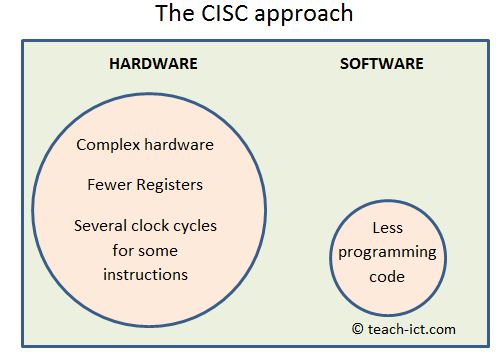2. CISC
One approach, Complex Instruction Set Computing, (CISC) comes from the view point that it is better to develop CPUs which carry a rich and full instruction set. The idea being that when a programmer is writing their code, practically any instruction they might require is there, readily available for them to use directly from the set.
Having all of these instructions available means that a programmer can write tight and efficient code.
For example: the programmer wants to multiply values A and B together.
They write their code to do this in a high level language, and the compiler (which creates the machine code) generates a single machine code instruction (from the instruction set) to carry out the task.
Because only a single instruction is required, less memory is needed.

However, on the negative side, having such a large instruction set in the first place leads to a large and complex CPU with many transistors.
Transistors use up power and consequently generate heat, meaning that the CPU requires additional cooling. CISC CPUs are usually built with a heat sink and/or fan which makes them larger in size than a RISC CPU.
These complex instructions can take several clock cycles to complete. This means that they take time to process.
The diagram above shows the concept of a CISC approach whereby having more complex hardware and a richer instruction set means that the programmer has to write less programming code.
So the trade-off is more complex hardware to support simpler software coding.
Challenge see if you can find out one extra fact on this topic that we haven't already told you Click on this link: CISC processors
